Heat Storm
The heat storm burned the new leaves on the blueberry bushes. Rhododendron, too.
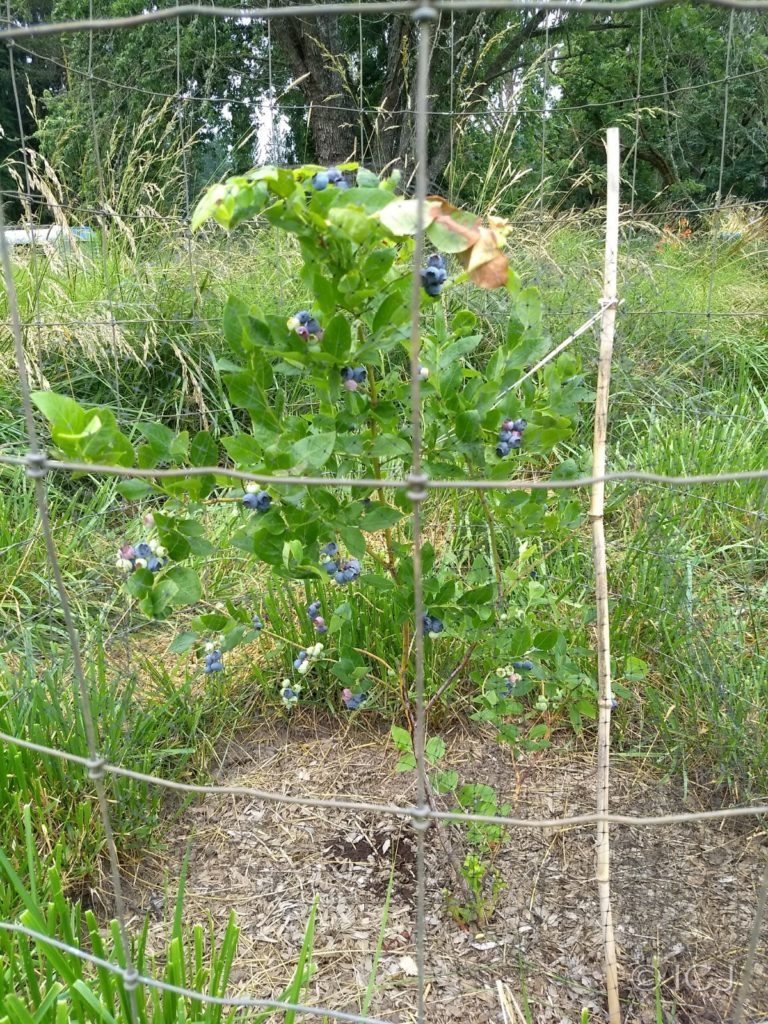
Day before the heat storm when temps were only in the mid-90’s, I cut 9” off my ponytail with a kid scissors. It was 18 months since I had gotten a hair cut due more to chemical sensitivities than COVID (I can’t breathe in normal salons) and the longest my hair has ever been. Afterward I looked like a horror-flick creepy doll with my hair down but it was much more comfortable that way.
I since have found a stylist who is self-employed in her own little shop who could take me for the first slot of the day so there were not yet too many ambient product fumes. My hair is respectable-looking and level now. It’s never fancy. Down when it’s clean. In a ponytail or bandana when it isn’t.
For four days I watered all the annuals every day instead of the usual 2-4 day rotation and twice as long as I usually do for the size of plant or time of year. Twice a day for potted plants and seedlings instead of the usual once. Every day for the blueberries as well, which otherwise get watered once a week or maybe twice if it is really hot and dry. Shrubs and saplings planted in the last two years, alternate days instead of at one-to-two week intervals.
Even so, most seedlings didn’t make it.
The tomatoes, both in ground and evacuated from greenhouse, stopped setting fruit and dropped their blossoms. What fruit they already had stopped sizing up. Several ripened the size that they were. Most waited a week or more to resume taking on color and did not resume bigger-ing. It was two weeks after the heat storm ended before new fruit started to appear.
Aside from the scorched new tender leaves, the blueberries themselves hung on fine. My neighbors who did not water every day lost most of theirs off plants much more established than mine.
If squash and cucumbers get drought stressed, the powdery mildew sets in and the leaves die off faster than new ones grow. Existing fruit will mature decently but they largely stop producing once half of their leaves are gone. Season’s over. Besides the crop loss you have to burn the plants (out of the question with the fire ban) or throw them in the garbage to keep the mildew spores from persisting in the compost and being worse the next year, wasting valuable biomass. I have been able to stave this off so far.
(If you are really truly hot-composting, this should kill the mildew, and mildewy and otherwise diseased or seedy plants are fine for urban compost bins because industrial-scale composting heats everything up pretty high. It’s chemical contamination you want to avoid passing on for soil-building in any form.)
Basil: Out of greenhouse (were nighttime temps just around 40?), onto porch for afternoon shade.
Peppers: Out of greenhouse, onto white plastic picnic table that serves as my kitchen counter & dish-washing station in the shade of the 10’x10’ pop-up shelter that serves as my outdoor kitchen. Peppers in 3-quart pots have to be off the ground or the bunnies and mice will get them.
Greenhouse tomatoes: Out of greenhouse and onto the ground under the pop-up shelter. These are in 5- or 8-gallon pots so safe from small critters unless they flop and some tender new growth or a tomato gets too close to the ground. Deer and elk, however, would love to prune them to a nub. Scrounge segments of fencing to cobble together a perimeter for the 10’x10’. Not much room to move under the shelter between the table, the cinderblock anchor, and 6 tomato plants sprawling over the edges of their large pots. It’s a good thing I don’t need to get in except to water anyway. I can cook what little I’m eating out in the oven hut and the dishes can wait.
Food: Out of cabin and in to root cellar. ‘Non-perishable’ things containing oil can turn rancid if held at high temperatures. 90 is enough. Proteins slowly denature above 104 and enzymes are killed instantly at 117. Chocolate and cooking oils first . . . priorities! Then nuts and nut butters, seeds, grains, flour, coffee and tea. Last, preserves in glass and boxed soups. Secure everything against mice in coolers or heavy duty plastic totes before stowing it away.
Water 4-6 hours a day, getting up at 5 am because it’ll be in the 80’s mid-morning and 90+ by noon. High of 100 Saturday 6/26. 105 on Sunday. 108 on Monday.
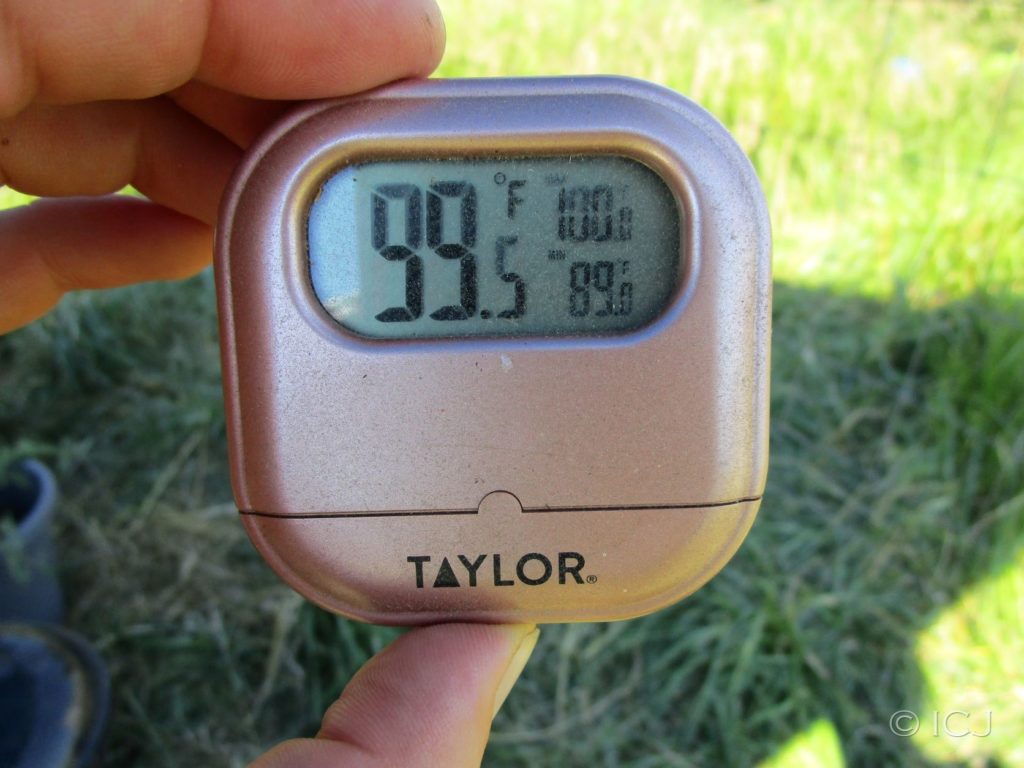
My little outdoor thermometer has a 24-hour memory programmed to reset at noon. I keep it on my furthest front step at night (no shelter from full range of cold due to building or trees) and on top of a plastic tote under the picnic table in the pop-up shelter during the day so that it is in 100% shade (even a minute of direct sun can skew the high temp severely) and so that it is not in any trapped air or being buffered by the relative cool of the ground. Besides optimizing accuracy, shuttling it between the two spots helps me to remember to write it down.
Saturday I sprayed myself with the hose several times but it was too humid for evaporative cooling to be effective. Sunday I walked a quarter mile on my 30 minute meal break (remote work for wage-paying gig) to sit in the creek for 5 minutes. Bringing down the core body temperature works wonders for presence of mind and restoring locomotion to at least half speed.
Guzzling water all day, sometimes with some Himalayan sea salt mixed in for electrolytes, but lost my appetite almost altogether for several days. Monday with no climate control and the sun beating on the steel roof, I had sweat running down my forearms and onto the keyboard and I started feeling woozy just standing still. On my break I filled two 5-gallon buckets about 2/3 full with 60-degree well water and stood in them for the duration of my shift. Just cooling the blood as it flowed through my calves and feet reduced the sweat level to a mere glisten and kept the fog in my skull from turning to steam and floating away. Clock off at 5 pm. Go straight to the lake (a 2-mile drive) and jump in.
For several days temps were still around 90 outside at twilight, hotter in the cabin, and worse yet in the loft where my bed is. Four nights in a row I slept on the porch. If one must be up with the sun a week after summer solstice in order not to lose one’s past three months of work and next three months of food, it helps if this is the view when you open your eyes. Turn your head sideways for the full effect.
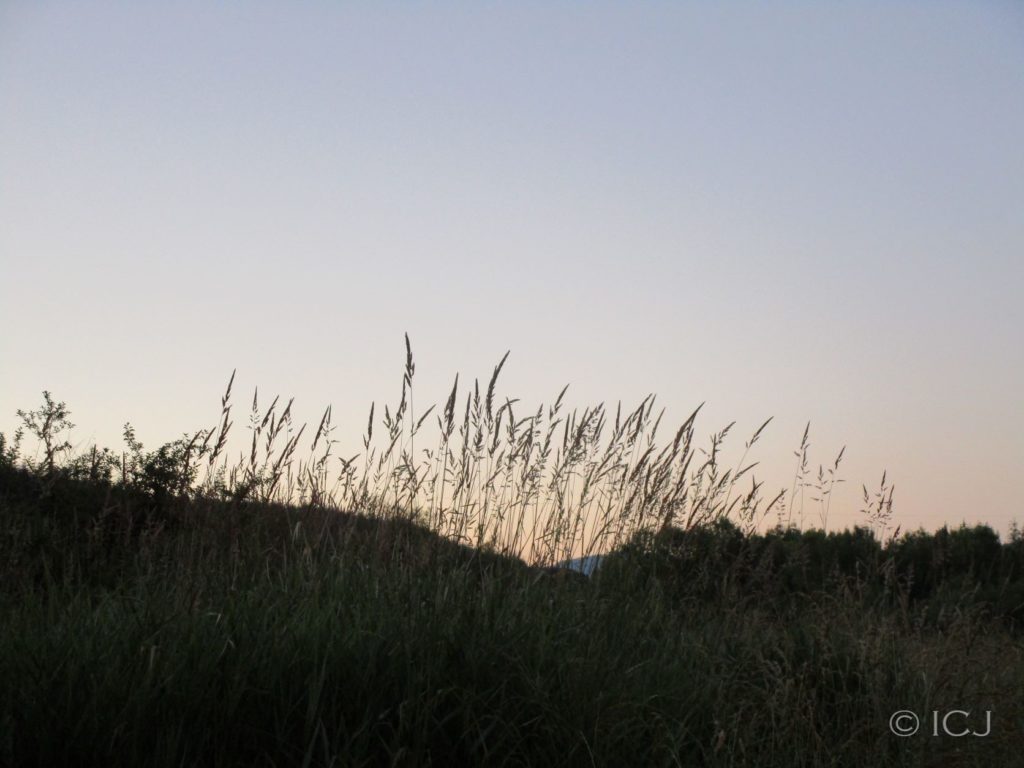
Withered slightly, less productive for a week or two if not for the season from the strain, but most of us made it through.
Foodshed Challenge Rundown: All food grown/raised/foraged/hunted in stated geographical area excepting imports allowed on Homegrown days (coffee, olive oil, salt, and yeast) + County and State days (chocolate, butter, maple syrup, and spices that do not grow in WA).
Homegrown Foodshed Day – July 1
The official local industry of Mossyrock is blueberries. This is for real. I have twelve blueberry bushes that I bought gallon-size last spring from Aldrich, a local multi-generation family farm. July is the month for blueberries, with a token few coming ripe in late June and early August. At my request, Glenn Aldrich himself assembled a sampler of different flavors and sizes with a range of early, mid, and late varieties. It’s working out well.
Year two marked a perceptible increase on year one, roughly guesstimating double from 2 lbs total to 4. Maybe this winter I will find where I wrote down last year’s harvest and add it up and compare it to the list from this year.
One is supposed to harvest blueberries every 4th day because they are their final shade of dark blue for an average of 4 days before they are fully ripe and sweet. Beyond that they start to shrivel and fall off the bush. Picking on this schedule lets you get them at optimum average flavor without losing many to being too far gone. Harvest from the previous evening, clockwise from upper left: Bluetta, Northland, Rencocas, and Bluecrop. (Edit: Not Rencocas. Toro. I checked my harvest records the evening after publishing. Rencocas should be the earlier variety but the Toro got a few in first. Most Toro are between dime and nickel size. I’ve had a few the diameter of a quarter. These were apparently too much in a hurry to finish growing. Perhaps the heat affected them.)
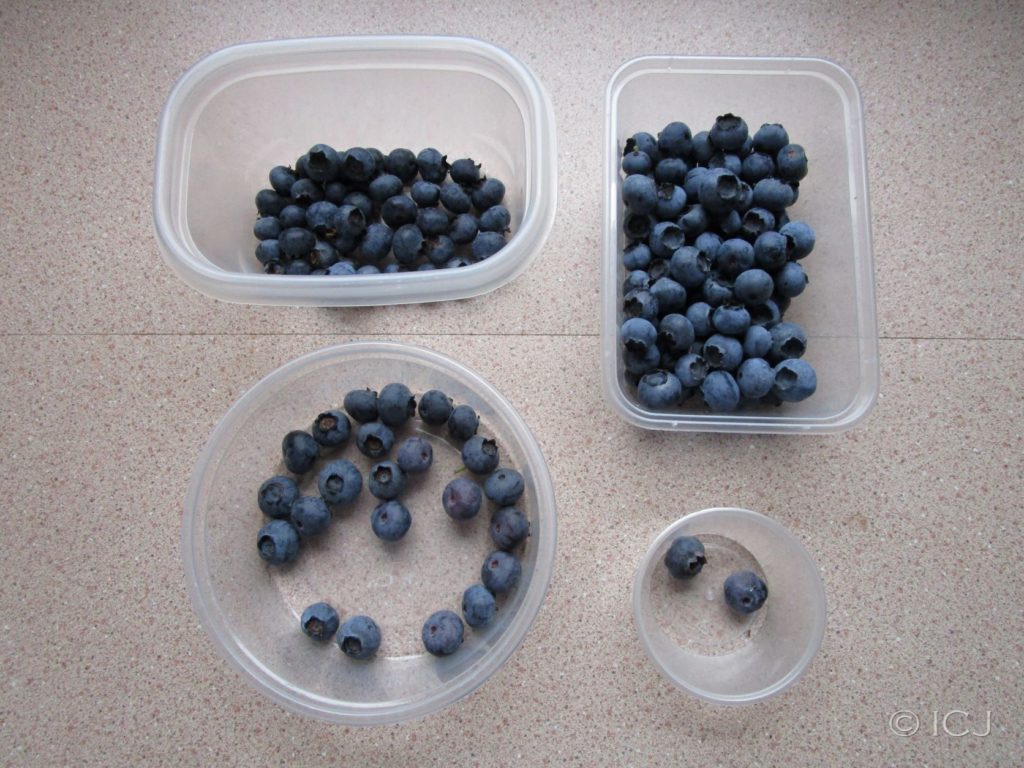
A few ounces every 4th day for a month is perfect for decorating pancakes, yogurt with granola, or oatmeal. Someday there will be pie and jam and smoothies and muffins featuring homegrown blueberries. Someday I will be measuring a day’s harvest in pounds and freezing them by the gallon. Someday!
Breakfast: Boiled Apple Mash and Rhubarb with Blueberries, Coffee
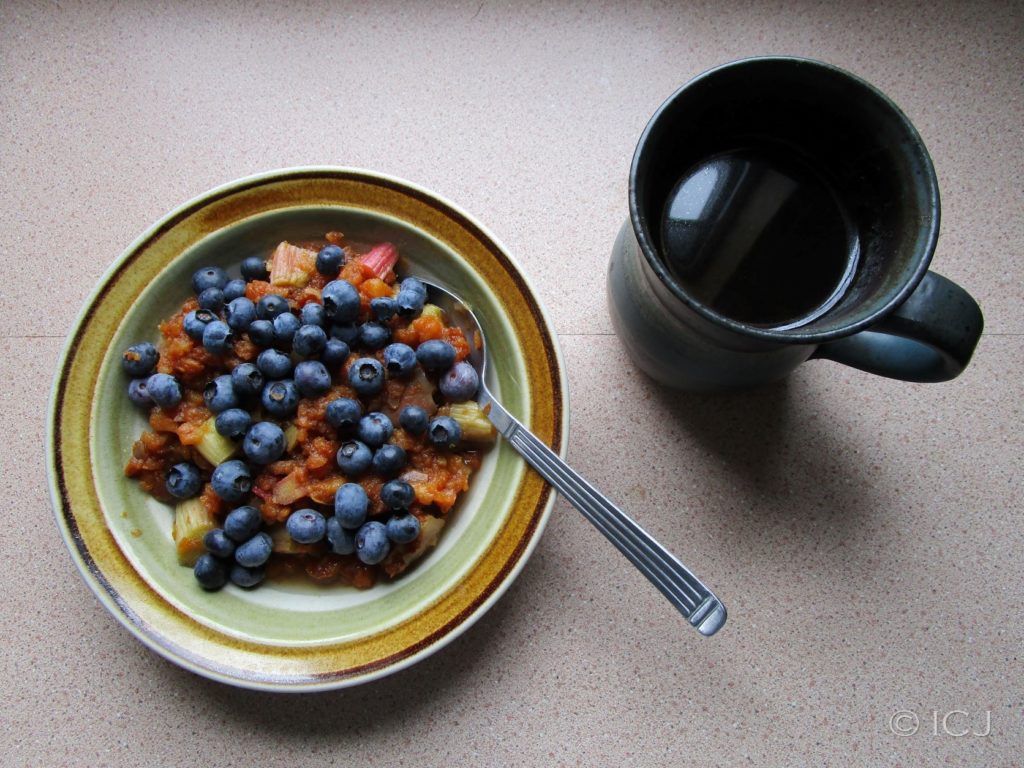
Morning Snack: Apple Rings, Chamomile Tea
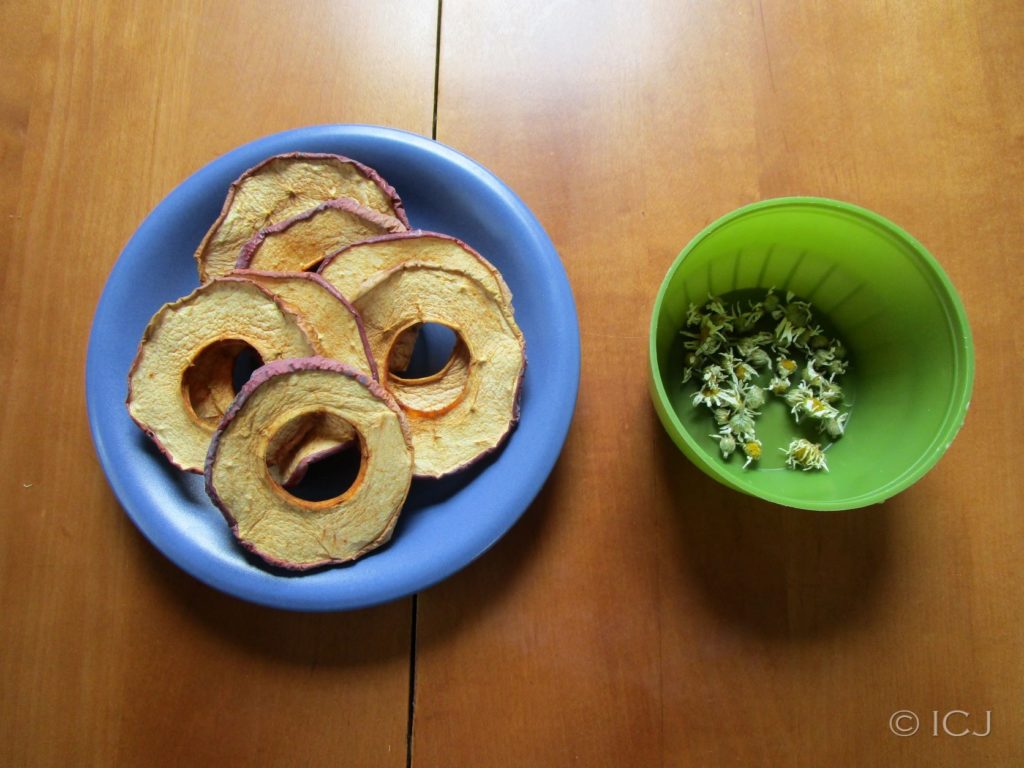
Last year I got just enough chamomile blossoms for one cup of tea. The chamomile plant started out as a wispy thing in a 3″ nursery pot purchased probably in June. I moved it into a gallon pot. By late summer it filled a 3 gallon pot, then died back completely over the winter. This spring I moved it up into a 10 gallon half-barrel. It is working on filling up that. Round one of flowers from this year is 6-8 cups of tea. I cut the stems back after flowering and the plant is starting in with fresh greens.
I anticipate the flowers filling one 8 oz glass jar, not packed in. This is about as as much chamomile tea as I drink in a year. The flavor is so much richer than storebought (even good-quality bulk), which is no surprise. What’s astonishing is that tea is only $20 a lb instead of $200. Chamomile will not be a cash crop for me.
Lunch: Snap Peas and Tomatoes
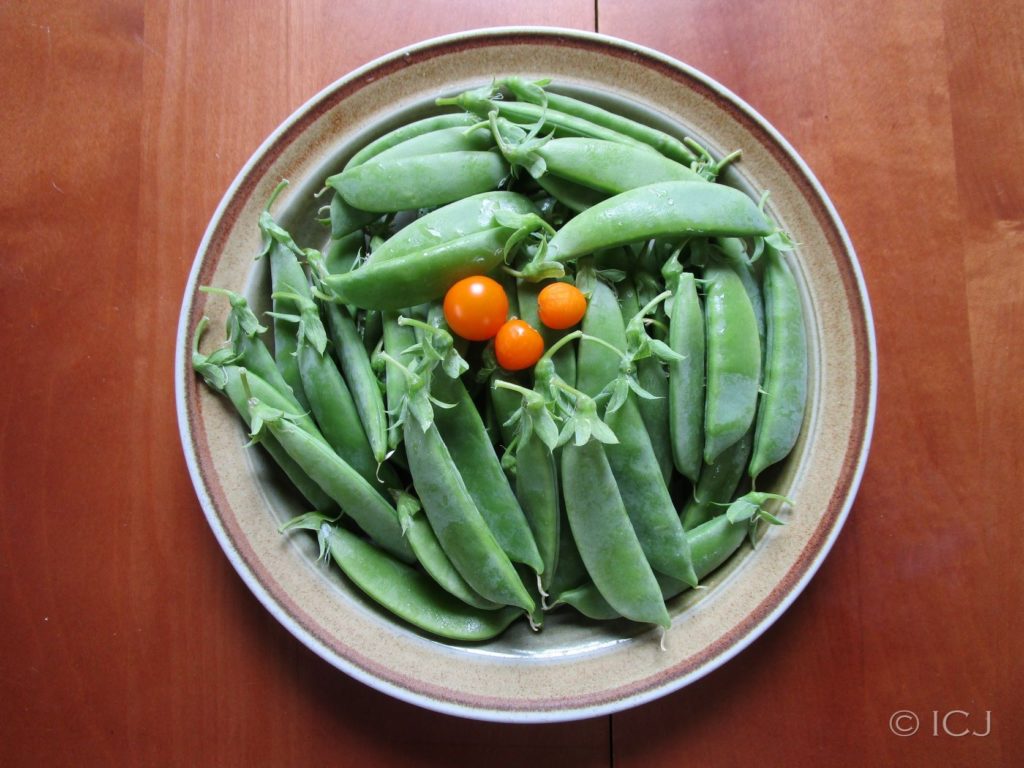
Half a pound of snap peas total, harvested alternate days over the course of a week. Snap peas are a cool season crop and don’t usually tolerate sustained temperatures much above 80. These not only survived the heat storm but started growing new sections of vine and put on a bunch of blossoms about a week after the heat subsided. They didn’t slow down and turn yellow enough for me to pull them out until late July. I will definitely be planting that variety again.
The tomatoes though. The first Sungold tomato ripened in the greenhouse on June 18. There were a good number sizing up right behind it. I thought I’d be able to collect at least a quarter pound on July 1 or several days before. Nevermind. Only ¼ oz due to the heat storm. A shriveled and runty piddling three. At least the garnish makes it look like a salad. Not that there is anything wrong with just a plate full of snap peas.
Afternoon Snack: Fruit Salad
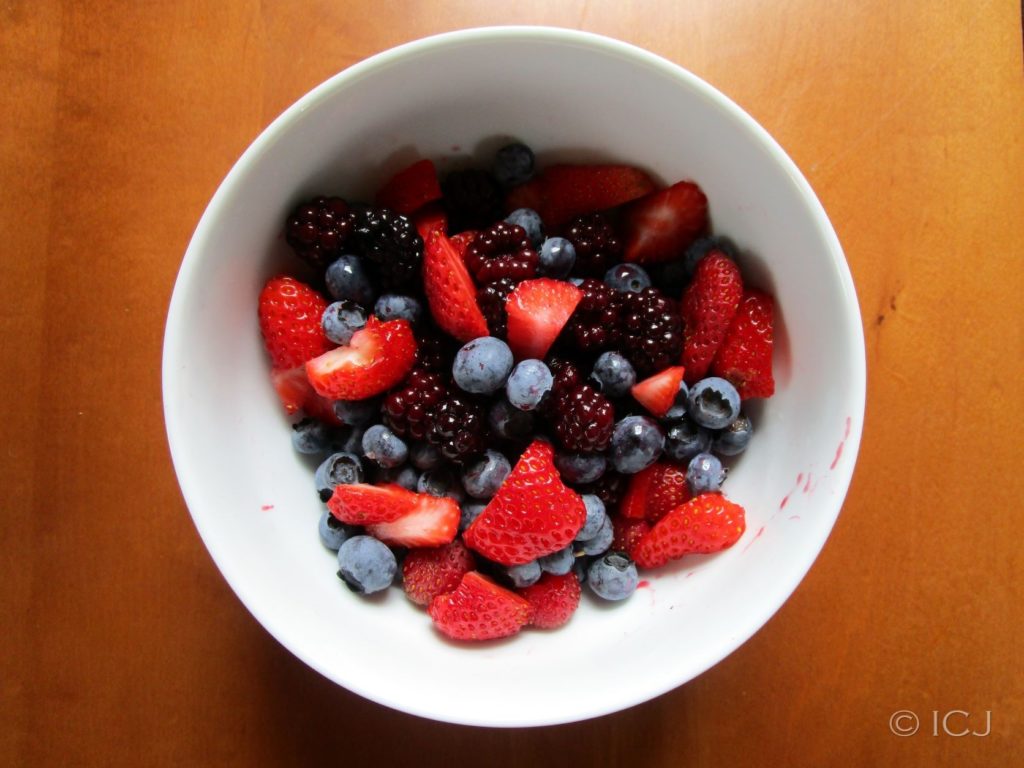
Strawberries and blueberries fresh from the garden. Some of the last blackberries from the freezer. It will be an eternal learning process optimizing how much of the harvest to put away and then rationing it to make it last but use it up before that type of produce starts coming in the next year.
I need another chest freezer already. What a delightful problem to have! A much bigger problem is where to put the chest freezer and be able to plug it in.
I also need to learn how to can, which will alleviate freezer overcrowding in the long run. Right now, however, I am not harvesting enough of anything all at once to make a big enough batch of anything to be worth canning. I would have to freeze several weeks’ or months’ yield and then thaw and can it to make room in the freezer for the next thing.
Dinner: Sauteed Squash Blossoms and Shallot, Salad, Cherries

I don’t recall having eaten squash blossoms before. They were beautiful and delicious. There are any number of recipes online for how to do this in fancy ways. I just sauteed thinly sliced shallot in olive oil and added the squash blossoms right at the end, stirring gently over low heat until they wilted. Ta da!
Fresh arugula, lamb’s quarters, and sorrel for the salad.
Wild black cherries from the massive and photogenic tree framed by my kitchen window. I can only reach about the bottom 10% even with the help of the 6′ orchard ladder (I’m not carrying the 10′ ladder around down there), which is just as well because as is I froze two gallon bags (one for making wine) and the fruit is so small relative to the pit that they would be nonsense to process for making pie. Rather yummy for munching fresh for a week and a half in late June through early July.
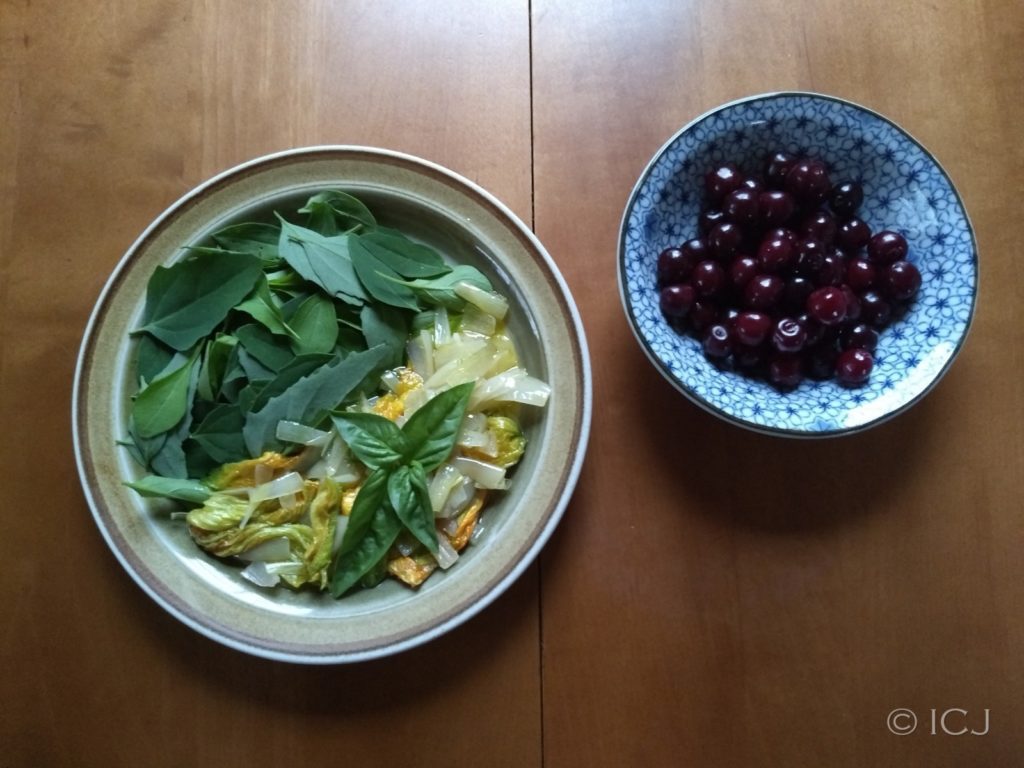
Over a month later as I write this, I am bracing myself for Heat Storm #2 to start two days from now. (Tomorrow from date of publication.) Here in the valley temps average 7 degrees warmer and colder than the forecast for town. 97, 104, 103, 92 were listed for Wednesday through Saturday at last glance. Could be four triple-digit days for me. With an hour less of daylight on either end than in June, at least perhaps the cabin will cool off a little more at night.
I will be really sad if there is a two-week gap in the tomato harvest again. Things were just starting to get real.
